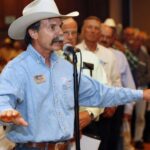

SAN ANGELO, Texas — Since a new framework for animal disease traceability was introduced by the U.S. Department of Agriculture last year, cattle raisers have been up in arms for fear that the centuries-old hot-iron branding methods may be on the way out.
Instead, the USDA wants every cow to have a unique numerical ID, stamped on an inexpensive ear tag, to make it easier to track animals from the ranch to feedlots and the slaughterhouse.
Even as the USDA says it never set out to undermine the traditional brand, cattlemen feel that when the government steps in it will make things more complex. They also fear the withdrawal of federal support for branding might embolden animal-rights activists who call the practice barbaric.
The new rules set to replace the National Animal Identification System were strongly opposed by numerous livestock industries and associations, including Fort Worth-based Texas and Southwestern Cattle Raisers Association.
Although Western movies showing cowboys branding cattle with a hot iron have created the image that the practice started in the Old West, documented history gives verification the practice goes back thousands of years to the days of the ancient Greeks, Arabians, Romans and Egyptians.
Branding was actually introduced to the New World in 1541 by Spanish explorer Hernando Cortez. Branding of cattle became common in the United States after the Civil War. It was said that brands of every shape and design were on Longhorns coming out of Texas during the great trail drives of the 1800s.
Brands are registered in Texas by the county clerk of the county in which a rancher runs livestock. The brand must be registered by the county clerk for the brand to be considered a legal means of ownership. Texas brands have to be re-registered every 10 years.
When I worked for The Cattleman magazine in Fort Worth during the mid-1960s, a favorite assignment was visiting the brand department to research histories of cattle brands. The brands allow TSCRA special rangers quick identification of stolen cattle.
The cattle raisers association has 29 special rangers stationed strategically throughout Texas and Oklahoma who have in-depth knowledge of the cattle industry and are trained in facets of law enforcement. All are commissioned as special rangers by the Texas Department of Public Safety and Oklahoma’s law enforcement agency.
TSCRA market inspectors aid the special rangers by collecting brands and other identifying marks on 4 million to 5 million cattle sold at 115 livestock markets each year. The market inspectors report their findings to TSCRA’s Fort Worth headquarters, where the information is entered in a database retrieval system. It is that database a special ranger checks when receiving a theft call.
“Branding’s the simplest, most efficient way to do it. Why change?” Wil Bledsoe, a Hugo, Colo., rancher, recently told the Wall Street Journal.
“It is a great deal easier in court when stolen animals are fire branded. Prosecutors prefer to try cases where the animals have been branded,” said Scott Williamson of Seymour, a TSCRA special ranger.
Modern cattle rustlers would delight in the current highly promoted electronic ID. Any cattle rustler could easily remove, replace, change and/or cut off ear tags and electronic pins.
The goal of the new USDA framework should be to enable the cattle industry, state and federal animal health officials to respond rapidly and effectively to animal health emergencies, say TSCRA officials.
Cattle raisers remain engaged with state and federal animal health officials to ensure that any animal disease traceability program is solely for the purpose of responding rapidly and effectively to animal health emergencies and does not affect ranchers’ ability to market cattle, officials said.
Jerry Lackey writes about agriculture. Contact him at jlackey@wcc.net or 325-949-2291.



